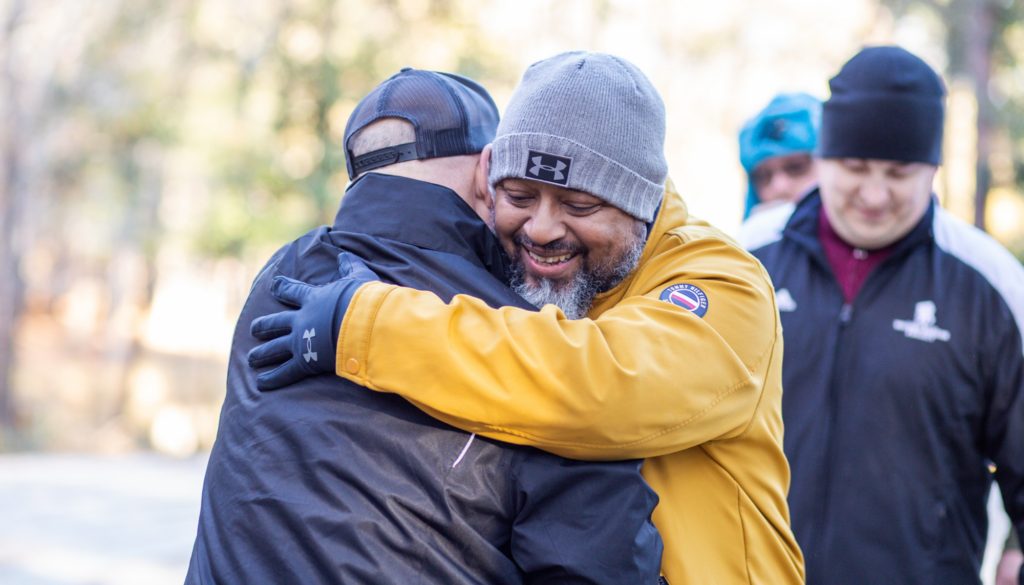POSTTRAUMATIC GROWTH IS A STUDIED SCIENCE
Originated by psychologists Dr. Richard Tedeschi, PhD,
and Dr. Lawrence Calhoun, PhD, in the mid-1990s.
We partner with the Boulder Crest Foundation to provide PTG programs and services for our veterans, military service members, and first responders.
What is Posttraumatic Growth?
LEARN THE PHASES OF POSTTRAUMATIC GROWTH
The phases of PTG serve as a road that participants must travel in order to achieve posttraumatic growth (PTG). This includes grieving what they’ve lost and rebuilding core beliefs.
TRUST AND CONNECTION
Trust and connection are essential to the PTG journey. At the heart of this phase are the program’s facilitators, known as Guides—alumni who continue to walk their own PTG path.
EDUCATION
Through education, we come to understand that the painful impacts of struggle are normal, and we realize that growth can arise from these experiences.
REGULATION
Regulation helps us create a calm, clear, and connected environment, enabling us to reflect and respond thoughtfully to the challenges we face.
DISCLOSURE
With the power of disclosure, we can start to openly share our traumatic experiences and explore their impact.
STORY
By committing to the hard work of education, regulation, and disclosure, we can start to rebuild—gathering the pieces of our lives and crafting a new chapter in our story.
SERVICE
When we make sense of our experiences, we gain the courage to share our stories with others, offering insight that can enrich their lives and empower them to struggle well.
FAQs About Posttraumatic Growth
What is the difference between PTS and PTG?
PTS and PTG can both stem from psychological challenges following a highly stressful or traumatic event. PTS is a clinical diagnosis characterized by multiple trauma-related symptoms, including re-experiencing the trauma (through intrusive thoughts, memories, flashbacks, or nightmares), avoidance behaviors (steering clear of people or situations tied to the trauma), cognitive distortions (memory loss, negative beliefs about life or the event, persistent low mood), and heightened negative symptoms (irritability, aggression, hypervigilance, being easily startled, or sleep issues). Posttraumatic growth, on the other hand, is a process of transforming struggle into a new direction, resulting in positive changes emerging from the aftermath of trauma. Some individuals may experience both PTS symptoms and post-traumatic growth simultaneously.
Is PTG tied to one specific traumatic event? What if there was a series of events that felt traumatic?
In combat, a single battle or engagement may not always trigger transformation; rather, an entire deployment in a war zone can serve as the catalyst. Similarly, a loved one’s terminal illness, unfolding over days or months with numerous interactions, can profoundly affect us. In these situations, pinpointing one specific event that disrupts our core beliefs can be challenging, as those beliefs may erode gradually through the accumulation of experiences that test our perspectives.
How do I know if I'm experiencing PTG?
It’s possible to recognize aspects of the PTG process surfacing after traumatic events. For instance:
Intrusive thoughts may gradually shift toward more intentional, reflective thinking. This could indicate the beginning of accepting the event and forming new core beliefs. We might notice ourselves or others sharing experiences that highlight themes of growth and transformation. Likewise, the way the story of the event is told may start to include PTG elements, such as newfound personal strength or fresh possibilities for life.
Observing these signs of the PTG process can signal that growth is underway. It’s key to understand that this growth can coexist with challenges, emotional pain, dysregulation, and even PTSD symptoms.
How long will it take me to experience PTG?
There’s no set timeline for posttraumatic growth (PTG). It starts when core beliefs are disrupted and can continue to develop over months or years.
Is PTG new? Why haven't I heard of it before?
While Dr. Tedeschi and Dr. Calhoun introduced the term posttraumatic growth in the 1990s, the concept that life challenges can lead to profound positive changes is ancient, appearing in spiritual, religious, literary, and philosophical traditions. What’s relatively recent is the structured exploration of this phenomenon by psychologists, social workers, counselors, and scholars across various clinical and scientific fields.
Help Serve Those Who've Served...
Your support helps us provide these life-changing programs and services at little to no charge to military service members, veterans, first responders, and their families. With your help, our Warriors won’t just survive — they’ll thrive.

